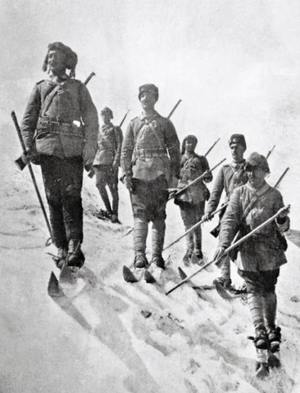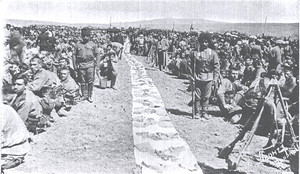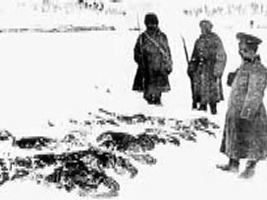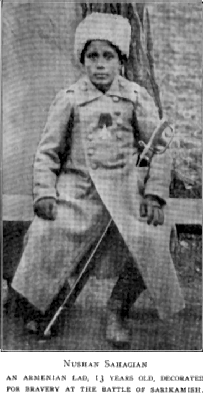معركة ساريقميش
| معركة ساريقميش Сражение при Сарыкамыше-Srazhenie pri Sarykamyshe Sarıkamış Muharebesi Battle of Sarikamish | |||||||
|---|---|---|---|---|---|---|---|
| جزء من حملة القوقاز في مسرح عمليات الشرق الأوسط في الحرب العالمية الأولى | |||||||
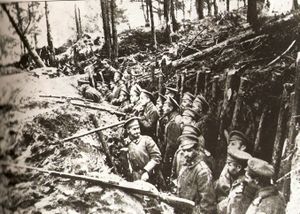 الخنادق الروسية في غابات ساريقميش. | |||||||
| |||||||
| المتحاربون | |||||||
|
المتطوعون الأرمن |
بدعم من: | ||||||
| القادة والزعماء | |||||||
|
|
| ||||||
| الوحدات المشاركة | |||||||
| جيش القوقاز الروسي | الجيش الثالث | ||||||
| القوى | |||||||
| 60,000[1][2][3] |
118,660[notes 1] 218 artillery pieces | ||||||
| الضحايا والخسائر | |||||||
|
16,000 killed and wounded 12,000 sick[5][6][7] |
33,000 killed 10,000 died in hospitals 10,000 wounded 7,000 captured[8] | ||||||
معركة ساريقميش (بالأرمينية: Սարիղամիշի ճակատամարտ (Sarighamishi chakatamart)، روسية: Сражение при Сарыкамыше; تركية: Sarıkamış Harekatı؛ إنگليزية: Battle of Sarikamish) كانت اشتباكاً بين الامبراطوريتين الروسية والعثمانية في الحرب العالمية الأولى. وقد نشبت من 22 ديسمبر 1914، حتى 17 يناير 1915، كجزء من حملة القوقاز.
The outcome was a Russian victory. The Ottomans employed a strategy which demanded that their troops be highly mobile and to arrive at specified objectives at precise times. This approach was based both on German and Napoleonic tactics.[9] The Ottoman troops, ill-prepared for winter conditions, suffered major casualties in the Allahuekber Mountains.[9]
Afterward, Ottoman leader Enver Pasha publicly blamed his defeat on Armenians and the battle served as a prelude to the Armenian Genocide.[10]
خلفية
Russia viewed the Caucasus Front as secondary to the Eastern Front, which enjoyed the major share of Russian resources. Russia had taken the fortress of Kars from the Turks during the Russo-Turkish War in 1877, when it was incorporated into the militarily administered Kars Oblast. After the Ottoman Empire entered the war in October 1914 on the side of the Central Powers, Russia now feared a Caucasus Campaign aimed at retaking Kars and the port of Batum.
From the point of view of the Central Powers, a campaign in the Caucasus would have a distracting effect on Russian forces. The Ottoman plan for this campaign found sympathy with German advisors, as a success in this region would mean a diversion of Russian forces to this front from the Polish and Galician fronts.[6] Germany supplied resources and the Ottoman Third Army was used in the battle.[11] The immediate strategic goal of the Caucasus Campaign was to retake Artvin, Ardahan, Kars, and the port of Batum. As a longer term goal, head of the Ottoman war ministry İsmail Enver hoped a success would facilitate opening the route to Tbilisi and beyond, which in turn would trigger a revolt of Caucasian Muslims.[6] Another Turkish—or rather German—strategic goal was to cut Russian access to its hydrocarbon resources around the Caspian Sea.[12]
التمهيد
المعركة
الميدان
المناورات الابتدائية، 22–28 ديسمبر
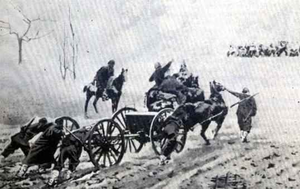
Hafız Hakki was at the left flank. His order was to move the IX and X Corps to Sarikamish and Kars. He contemplated a two step plan: a sudden initial attack and a second step with both Corps proceeding at full speed towards Oltu. He expected the assault at Narman to be concluded by the afternoon of December 22. Then the Corps would march 30 kilometers a day and arrive in the Kars-Sarikamish line by December 25. Two divisions of the Stange regiment had been sent by sea from Constantinople to Trabzon.
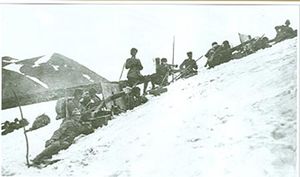
On December 24, Hafız Hakkı was well beyond Oltu after having marched 75 kilometres (47 mi) in just over three days. However, they were not at the Kars-Sarikamish line as planned.
The X Corps suffered a delay of 24 hours in the Barduz Pass, and 4th battalion of the Armenian volunteers lost 600 troops in a battle there.[13]
الهجوم في ساريقميش، 29 ديسمبر
الوقوع في مصيدة نصف دائرة، 2–3 يناير
On January 2, Russian artillery fire caused severe casualties. Enver received two reports; one was from the chief of staff of the IX Corps, Lieutenant Colonel Şerif, and the other from Colonel Hafız Hakkı. Both reports said that they were too weak to launch another attack. Enver responded to the units: "The offensive is to go on at full strength." Later Enver focused on securing routes for the retreat instead of insisting on new attacks to take Sarikamish. He combined the two corps and renamed it the "Left Wing Army." He promoted Colonel Hafız Hakkı to Brigadier General and gave him command of the Left wing Army.
On January 3, IX Corps were driven out to the same direction, in which the remnants of the X Corps were also retreating.[9] Hafız Hakkı was hoping for reinforcements. He did not order his units to retreat as he believed it could be still possible to take Sarikamish. Meanwhile, around 40 km south, the XI Corps led by Galip was renewing attacks on Russian lines in an attempt to relieve the pressure on the IX and X Corps positioned in front of Sarikamish. The Russians were advancing and the circle was getting narrower.
On January 4, Hafız Hakkı toured the front line. He told İhsan that the battle was over unless some of the troops في جبال الله أكبر were still alive.
الانسحاب، 4–15 يناير
On January 6, the 3rd Army headquarters found itself under fire. The Russians captured the entire 28th Division. The 17th and 29th Divisions were taken prisoner. Eight senior officers including İhsan surrendered to the Russians. Among the captives, 108 officers and 80 soldiers transferred to Sarikamish. Hafız Hakkı managed to safely reach the headquarters of X Corps. He was told that IX Corps had fallen into the hands of Russians and ordered a total retreat. On January 7, the remaining forces began their march towards Erzurum.
On January 11, after four days of travel, Enver and the German officers reached Erzurum. They had stipulated in their original plan that the same route could be taken by the advancing 3rd Army in two days. The transports dispatched from Constantinople which attempted to land troops and provisions at Trabzon were sunk by a Russian Black Sea squadron and warships.[9] The escorts SMS Goeben and TCG Hamidieh were chased back to the Bosporus.[9]
On January 17, the remnants of the Ottoman forces in the woods outside Sarikamish were collected, which signaled the end of fighting on this front.[6] The Russian right wing cleared the Choruk Valley. Enver's project ended in failure after three weeks of struggle amid high mountains and deep snowdrifts.[9] For a time, at least, Russia was secure from attack in the Caucasus.[9] Hafız Hakkı expected that the Russians would use this success to capture the Erzurum Fortress. The 3rd Army immediately tried to take measures,[14] but this proved to be nearly impossible as all the local reserves were depleted.[14]
On February 12, Hafız Hakkı died of typhus at the age of 36.[14] Otto Liman von Sanders, who had been asked before, rejected the position again.[14] Mahmut Kamil took the command of the Army. War minister Enver never commanded troops in battle again. A German officer attached to the army wrote later, the Ottoman 3rd army had "suffered a disaster which for rapidity and completeness is without parallel in military history."[15]
الخسائر
The Ottoman 3rd Army started with 118,000 fighting men. It was reduced to 42,000 effective soldiers in January 1915, with an additional 12,000 in the Erzurum fortress garrison. 25,000 Turkish troops had become casualties even before the battle started,[7] 30,000 frozen bodies were found by the Russians after the battle,[16][17][18] and the entire Third Army was reduced to no more than 12,500 men.[18][17] There are conflicting figures for Ottoman casualties, though it is clear that the Ottoman casualties were definitely huge, and the military hospitals of the Erzurum area were overflowed with wounded and sick.[19] Sources do not agree on what should be included in the final sum. The Turkish official history and medical records states 33,000 KIA, 10,000 died in hospitals, 7,000 prisoners, 10,000 seriously wounded, for some 60,000 total irrecoverable casualties. Another estimate given by the German Commandant Larcher is 90,000 dead and 40,000–50,000 captured, which is often repeated in modern recountings of the battle.[19] However, such figures are considered unreliable, both because they exceed the total strength of the entire Third Army and because the actual Chief of Staff of the Third Army (also a German), Lieutenant Colonel Guse, gave casualties as 37,000 dead and 7,000 missing based on operational returns.[20] Artillery loses were 12 field artillery pieces and 50 mountain artillery.
The casualties of the conflict escalated beyond the end of the active warfare period as the most immediate problem confronting the 3rd Army became the typhus epidemic.[14] TAF presents a figure of 60,000 casualties throughout the period of the operation. The Russians took 7,000 POWs including 200 officers. These prisoners were kept under confinement for the next three years in the small town of Varnavino east of Moscow on the Vetluga River. After the final days of the Russian Empire, these soldiers had a chance to return to the ailing Ottoman Empire.
Russian losses were up to 30,000: 16,000 killed and wounded and 12,000 sick/injured,[5][6][7] mostly due to frostbite.[6]
التقديرات
المشاة الخفيفة
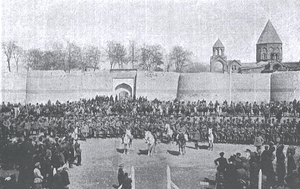
During the battle, light infantry was used by both sides. The detachment of Armenian volunteer units on the Russian side, and the detachment I Corps unit under the control of Stange, provided a skirmishing screen ahead of the main body of infantry, harassing and delaying of the enemy advance or preventing them escaping.
The Armenian detachment units were credited in no small measure for the success of the Russian forces, as they were natives of the region, adjusted to the climatic conditions, familiar with every road and mountain path, and were fierce and resolute in combat.[22] The Armenian units were small, mobile, and well adapted to the semi-guerrilla warfare.[23] They did good work as scouts and took part in many severe engagements.[23] Armenian detachment battalions challenged the Ottoman operations during critical times: "the delay enabled the Russian Caucasus Army to concentrate sufficient force around Sarikamish".[24]
الأرمن
The relationship between the Ottoman Empire and its Armenian population had already started to deteriorate after numerous Armenians were massacred throughout the empire during the 1890s.[25][26][27] During July 1914 there were negotiations between the Committee of Union and Progress (CUP) and Armenian intelligentsia at the Armenian congress at Erzurum. The public conclusion of this congress was "ostensibly conducted to peaceful advance Armenian demands by legitimate means".[28] The CUP regarded the congress as the seedbed for establishing insurrection.[29] Historian Edward J. Erickson concluded that after this meeting the CUP was convinced to pursue strong Armenian—Russian links with detailed plans to detach the region from the Ottoman Empire.[29]
On his return to Istanbul, Enver blamed his failure on the actions of the region's local Armenians.[10][30]
Repressive measures taken against the empire's Armenian population were an early stage of the Armenian Genocide.[31][32][33][34][35][36][37] This policy towards the Armenians was paralleled on a smaller scale in Ottoman policy that led to the Greek Genocide against the Pontic Greeks and Caucasus Greeks of Kars Oblast, also on the pretext that like the Armenians they too had fought in or collaborated with the Russian Caucasus Army at Sarikamish and elsewhere on the Caucasus Campaign.
إشارات ثقافية
- Ballads (تركية: Ağıtlar) was a book published in 1943 by يشار كمال. It is a compilation of folk themes that include accounts of معركة ساريقميش.
- Vetluga Memoir is a historical document that describes the political and strategic mistakes made by the Ottoman Third Army, and the final days of one corner of the Tzarist empire written by a young Turkish officer captured by the Russians.[38]
- 120 is a 2008 Turkish film about 120 children who died carrying ammunition to the battle.
- الطريق الطويل إلى البيت The Long Way Home هو فيلم تركي من انتاج سنة 2013 عن مجموعة من سبعة أشخاص وسعيهم للهرب من منطقة القتال في ساريقميش.
الهامش
- ^ Mikaberidze A. Conflict and Conquest in the Islamic World: A Historical Encyclopedia. ABC-CLIO. 2011. P. 798
- ^ Eggenberger D. An Encyclopedia of Battles: Accounts of Over 1,560 Battles from 1479 B.C. to the Present. Courier Corporation. 2012. P. 386
- ^ Pope S., Wheal E.-A. Dictionary of the First World War. Pen and Sword. 2007. P. 421
- ^ خطأ استشهاد: وسم
<ref>غير صحيح؛ لا نص تم توفيره للمراجع المسماةorder57 - ^ أ ب Allen W. E. D., Muratoff P. Caucasian Battlefields: A History of the Wars on the Turco-Caucasian Border 1828–1921. Cambridge University Press. 2011. P. 284
- ^ أ ب ت ث ج ح Eugene Hinterhoff, The Campaign in Armenia. Marshall Cavendish Illustrated Encyclopedia of World War I, vol ii, pp. 499–503.
- ^ أ ب ت Joshua A. Sanborn. Imperial Apocalypse: The Great War and the Destruction of the Russian Empire. Oxford University Press. 2014. P. 88
- ^ Erickson, Ordered to Die, pp. 59–60.
- ^ أ ب ت ث ج ح خ خطأ استشهاد: وسم
<ref>غير صحيح؛ لا نص تم توفيره للمراجع المسماةEncyAm404 - ^ أ ب Balakian, Peter (2003). The Burning Tigris: The Armenian Genocide and America's Response. New York: HarperCollins. pp. 25, 178, 445. ISBN 0-06-019840-0.
- ^ A. F. Pollard. A Short History Of The Great War. chapter VI: The first winter of the war.
- ^ The Encyclopedia Americana, 1920, v.28, p. 403.
- ^ أ ب Garegin Pasdermadjian, "Why Armenia Should be Free" p. 21.
- ^ أ ب ت ث ج Erickson, Ordered to Die. p. 62.
- ^ David Fromkin. A Peace to End All Peace: The Fall of the Ottoman Empire and the Creation of the Modern Middle East. Macmillan. 2010. P. 121
- ^ Hew Strachan. The First World War: To arms, Volume 1. Oxford University Press, 2001. P. 728
- ^ أ ب Leila Tarazi Fawaz. A Land of Aching Hearts: The Middle East in the Great War. Harvard University Press. 2014. P. 43
- ^ أ ب Alan John Percivale Taylor. The Illustrated History of the World Wars. Octopus, 1978. P. 52
- ^ أ ب Erickson, Ordered to Die. p. 60.
- ^ Erickson 2001, p. 60
- ^ خطأ استشهاد: وسم
<ref>غير صحيح؛ لا نص تم توفيره للمراجع المسماةRic367 - ^ Hugh Chisholm, 1920, Encyclopædia Britannica, twelfth edition, p.198.
- ^ أ ب Avetoon Pesak Hacobian, 1917, Armenia and the War, p.77
- ^ Garegin Pasdermadjian, "Why Armenia Should be Free", p.22
- ^ Fromkin, David, A Peace to End All Peace, New York: Henry Holt & Co., 1989, p. 211. ISBN 0-8050-6884-8
- ^ Suny, Ronald, Looking Toward Ararat:Armenia in Modern History, p.46. Indiana University Press, 1993. ISBN 0-253-20773-8
- ^ Charny, Israel W., Encyclopedia of Genocide, p.287. ABC-CLIO, 1999. ISBN 0-87436-928-2
- ^ Richard G. Hovannisian, The Armenian People from Ancient to Modern Times, p. 244.
- ^ أ ب (Erickson 2001, pp. 97)
- ^ David P. Forsythe, ed. (2009). Encyclopedia of human rights. Oxford: Oxford University Press. p. 96. ISBN 0195334027.
- ^ Armenian Genocide on Fareed Zakaria’s TV show
- ^ Walker, Christopher (1980). Armenia: The Survival of a Nation. New York: St. Martin's Press. p. 199. ISBN 0-7099-0210-7.
- ^ Palmer-Fernandez, Gabriel. Encyclopedia of Religion and War, p.139. Published 2003, Taylor & Francis. ISBN 0-415-94246-2
- ^ Tucker, Spencer. World War I, p.394. Published 2005, ABC-CLIO. ISBN 1-85109-420-2
- ^ Balakian, Peter. The Burning Tigris, p.184. Published 2003, HarperCollins. ISBN 0-06-019840-0.
- ^ Akcam, Taner. A Shameful Act, p.143. Published 2006, Henry Holt & Co. ISBN 0-8050-7932-7.
- ^ Peterson, Merrill D. Starving Armenians: American and the Armenian Genocide 1915–1930, p.30. University of Virginia Press 2004. ISBN 0-8139-2267-4.
- ^ Mehmet Arif, Ölçen (1995). Vetluga Memoir: A Turkish Prisoner of War in Russia, 1916–1918. University Press of Florida. p. 246. ISBN 978-0-8130-1353-4.
ملاحظات
ببليوگرافيا
- Tucker, Spencer (1998). The Great War, 1914–18. Indiana University Press. p. 272. ISBN 978-0-253-21171-2.
- Erickson, Edward J. (2001). Ordered to Die: A History of the Ottoman Army in the First World War. Greenwood Publishing Group. p. 256. ISBN 978-0-313-31516-9.
- Muratoff, Paul (1953). Caucasian Battlefields: A History of the Wars on the Turco-Caucasian Border 1828–1921. Cambridge University. p. 636. ISBN 0-89839-296-9.
- Hinterhoff, Eugene (1984). The Campaign in Armenia. Marshall Cavendish Illustrated Encyclopedia of World War I, vol ii. New York: Marshall Cavendish Corporation. pp. 499–503. ISBN 0-86307-181-3.
- Pasdermadjian, Garegin (1918). Why Armenia Should be Free: Armenia's Rôle in the Present War. Hairenik Publishing Company. p. 45.
- Pollard, A. F. (1920). A Short History of the Great War. London. p. 45. ISBN 1-4264-2248-2.
- Hacobian, Avetoon Pesak (1917). Armenia and the War: An Armenian's Point of View with an Appeal to Britain and the Coming Peace Conference. Hodder and Stoughton. p. 200.
وصلات خارجية
- Pages using gadget WikiMiniAtlas
- Coordinates on Wikidata
- Articles containing أرمنية-language text
- Articles containing روسية-language text
- Pages using Lang-xx templates
- Articles containing إنگليزية-language text
- Articles with unsourced statements from September 2014
- تاريخ تركيا
- 1914 في الدولة العثمانية
- 1915 في الدولة العثمانية
- تاريخ أرمنيا
- نزاعات 1914
- نزاعات 1915
- Armenian Genocide
- معارك حملة القوقاز
- معارك الحرب العالمية الأولى التي شاركت فيها الدولة العثمانية
- Battles of World War I involving Russia
- 1914 في أرمنيا
- 1915 في أرمنيا
- أنور پاشا
- History of Kars Province
- Kars Oblast
- 1914 in the Russian Empire
- 1915 in the Russian Empire
- أحداث ديسمبر 1914
- أحداث يناير 1915

